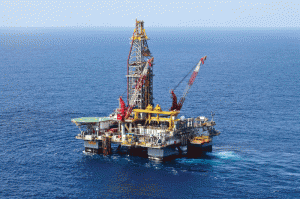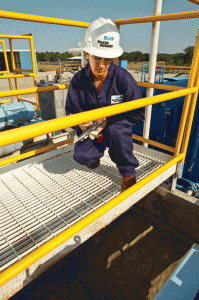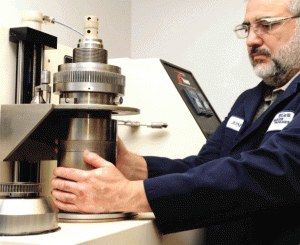Advanced oil-based, synthetic muds enable deeper, hotter wells
Amid increasingly difficult drilling challenges, operators look to only the best drilling fluids – irrespective of cost
By Katie Mazerov, contributing editor
Beyond the hardware required for today’s complex wells and state-of-the-art drilling and completion systems, advanced fluid technologies are keeping pace, making a high-profile entry to the marketplace in response to operators’ needs to get wells online faster, with higher rates of penetration (ROP) and cleaner operations. Lubricity and viscosity are the watchwords of this sector, with the continued emergence of sophisticated water-based mud (WBM) and synthetic-based fluids that are delivering both economic and environmental benefits in regions ranging from unconventional shale plays to deepwater to extreme high-pressure, high-temperature (HPHT) environments.

“Water-based fluids are seeing a revival due to environmental reasons, so it is logical to expect advances in technical performance in this area,” said Dr Klisthenis Dimitriadis, chief well engineer for Tullow Oil. “However, there is a technical limit to what can be achieved with water-based fluids, especially in the short and medium terms. For this reason, I believe advances in the environmental performance of synthetic-based fluids can be expected to occur faster, in combination with improved treatment and new drilling techniques.”
He cited improvements in de-oiling equipment and riserless mud recovery as example of that trend.
Economics is also a factor, and to that end, the industry needs to take the long view, Dr Dimitriadis maintains. “Today’s drilling challenges are so unforgiving that usually only the best drilling fluid will do, irrespective of cost,” he said. “This is proven every time a lifecycle cost calculation is performed. In cases where a lot of uncertainty exists, selecting the highest-spec fluid – even when you might not need it – is in fact a cost-effective insurance for reducing exposure to potentially very expensive problems.”
Tullow Oil carefully considers the impact of its footprint for all of its global ventures, he noted, citing examples from Uganda, Kenya and French Guiana. “We operate in sensitive areas and pride ourselves on minimizing and mitigating the environmental and social impact of our operations.”
Fluids tailored for operators
High-performance WBM is increasingly being used in US oil shale plays, such as the Bakken and the Bone Spring formation in West Texas. But every region is different, and often fluids are tailored to meet an operator’s preferences and drilling practices in addition to the geology of a particular area, said Harry Dearing, vice president of technology marketing for Newpark Drilling Fluids.
“We’re also seeing a move toward using more produced brines instead of conventional drilling fluids in some of the oil plays, particularly the Bakken region,” he said. “These fluids are much simpler, and with the addition of performance additives, an operator can realize a lower-cost well and also drill faster. In some cases, this process is being used with managed pressure drilling (MPD) techniques. An operator can use available fluid and manage pressure without having to do a lot with the mud density.”
Drilling in the Bakken lends itself to using water or diesel oil-based mud for portions of a well, Mr Dearing continued. “In many cases, operators are not using one particular system; often, they use different systems for different intervals. In most wells, an evaporite section that contains tectonically active salt formations requires well-cemented casing in a uniform wellbore to avoid casing collapse during production,” he explained. “Diesel-oil-based mud (DOBM) has reliably mitigated that risk historically in the intermediate section by providing a uniform wellbore. The produced brine drilling fluid systems can then be used in the production interval.”

There is also a movement toward water-based systems in the Eagle Ford; however, DOBM has historically been used in that region, and the regulatory environment does not mandate the use of water-based systems, Mr Dearing said. “We’re seeing interest in WBMs, and they are cost-effective in many circumstances. But, where the drilling is routine and lost circulation is not an issue, operators tend to use what they are familiar with – the standard diesel-oil mud.”
Newpark’s Evolution drilling fluids system is a high-performance WBM that has been used in many of the shale reservoirs, delivering improved lubricity in long laterals. Developed in collaboration with a major shale operator for use in unconventional oil and gas plays, the system reduces friction between the drill string and the casing in the wellbore. “This allows an operator to drill longer laterals and drill them faster,” Mr Dearing said.
Increasing ROP, reducing costs
Baker Hughes has seen its LATIDRILL high-performance, water-based drilling fluid system perform as well or better than OBM systems while drilling extended-lateral well sections in the Eagle Ford. The system offers excellent lubricity with enhanced wellbore stability features designed to drill faster and prevent sloughing shale, fluid loss and borehole enlargement, said Ron Foley, product manager for Drilling and Completion Fluids, Baker Hughes. “We can significantly increase ROP, thereby reducing time in the borehole.”
Mo Tej, product line manager for Water-based Fluids, Baker Hughes, added that the reduced WBM clean-up and disposal costs translate to lower operating costs for operators. “From a rig spread perspective, if we can reduce the time for clean-up and thus move more quickly between locations, we can save considerable rig time,” he said. “Also, with WBMs, we eliminate the step of having to transport the cuttings to a disposal site, resulting in mud cost savings of up to 30%.”
The company has launched a new invert emulsion, or synthetic-based mud (SBM) system, to achieve higher lubricity in US shale plays, including the Utica and the Marcellus – regions that traditionally were drilled with WBMs, using salt water or brine as a base, and polymers. The NEXT-DRILL high-performance drilling fluid platform, including the NEXT-DRILL eC synthetic-based system, was introduced in 2011 and will roll out in additional US and international basins this year.
“NEXT-DRILL eC is a true synthetic-based drilling fluid for oil and gas land plays that is environmentally benign, runs lower viscosities and has a high-solids tolerance. It has been a strong performer in achieving greater ROP and hole stability,” said Steve Spence, product line manager for Baker Hughes’ Emulsion Drilling Fluids product line. “Invert emulsion muds are more lubricious than WBMs and are very suited for wells characterized by shallow depths and extremely long reach-outs,” he continued.” Along with lubricity, they also provide enhanced shale stability and good hole-cleaning.
“The shales we’re seeing today tend to be more mature, less reactive and don’t have the tendency to swell as rapidly as the shales we’re accustomed to drilling,” Mr Spence said. “However, they are still water-sensitive, and the enhanced inhibition provided by invert emulsion muds is designed for water-sensitive materials. Prior to the introduction of invert emulsions, operators often needed to pull the completion casing, make a hole-opener run and then rerun-casing before successfully landing casing on the bottom.
“By using invert emulsions in shale drilling projects, remedial hole-opener runs and repeated casing attempts have been virtually eliminated, significantly reducing drilling time and allowing operators to see first production sooner and replace depleting wells quicker, resulting in better economics.”

Extreme environments
The move into extreme deepwater and HPHT reservoirs, where the temperature may be cool at the mudline but very warm at the bottom of the hole, is also driving the trend toward emulsion-based fluids designed to reduce viscosity and equivalent circulating density (ECD).
“These temperature changes can drastically affect the properties of drilling fluid,” Mr Spence said. “Much of drilling fluid management for deepwater is focused on maintaining inhibition in fairly reactive shale and clay, providing hole stability in under-compacted formations and narrow pore pressure and fracture pressure windows.” The underlying challenge is controlling the viscosity of the fluid while cleaning the hole.
In 2001, the industry began developing constant rheology profile drilling fluids that can limit viscosity variations driven by the wide temperature differences that are characteristic of the deepwater drilling environment. Baker Hughes has developed the RHEO-LOGIC synthetic-based mud, which is designed to reduce ECD and viscosity in deepwater drilling environments, Mr Spence said. “For extreme HPHT wells, an invert emulsion system called MAGMA-TEQ has been deployed on many projects and has demonstrated temperature stability up to 500°F and pressures exceeding 30,000 psi.”
Transitioning to the completion phase, a process that involves displacing synthetic- or oil-based drilling mud to a completion brine, is also complex in HPHT environments. “Maintaining viscosity of the lead spacer is critical when we’re moving the mud out of the hole,” said Clark Harrison, product line manager, Completion Fluids, Baker Hughes. “When well temperatures are above 300°F, the polymers used to viscosify the spacers can easily degrade, and the products used for cleaning can lose efficacy, thereby preventing proper hole-cleaning. Therefore, special attention must be given to ensure the products can withstand these harsh conditions to effectively clean the wellbore.”
A high-temperature cleaning agent, PRIME 200 HT, is part of the company’s mesophase portfolio that removes synthetic- and oil-based residue for HPHT displacements. PRIME VIS HT is the viscosifier for the spacer and can withstand temperatures up to 450°F in high-density brines.

“The technology is solvent-free, and in one circulation, we completely remove all OBM residue and water-wet all downhole surfaces,” said Tom Jones, director of Reservoir Services, Baker Hughes. Additional mesophase technology includes products such as MICRO-CURE E2, a cased-hole remediation system that removes multiple forms of damage caused by drilling, completion and production operations, and MICRO-WASH, a product used to removed OBM/SBM filter cakes or other oily residue in open-hole completions.
The growing complexity of open-hole completions is driving development of advanced filter cake removers, or breakers, that provide better control, said Charles Svoboda, director of Wellbore Productivity, Business Development, for M-I SWACO. “Open-hole completions are where the challenges are and where the industry will continue to go in the future,” he said.
Open-Hole Completions
Completions have advanced over the years from simple, standalone slotted liners and wire-wrapped screens to more advanced, premium screens and open-hole gravel packs with screens in place. “Open hole completions are also becoming longer, so inflow control devices (ICDs) and swellable packers come into play to provide zonal isolation to enable production from all the segments of the reservoir that have been drilled or contacted,” Mr Svoboda added.
All this advanced hardware makes the completion process more complex and more difficult to overcome the filter cake, which minimizes invasion into the formation during drilling and completion operations. The filter cake must be removed to allow reservoir fluids to flow freely into the wellbore or, in the case of injector wells, to be able to inject into the formation the volumes needed to effectively move oil across the field, he explained.
In recent years, M-I SWACO has focused on breakers for OBM and WBM systems that are designed to work slowly, dissolving the filter cake while other operations are under way. On the North Slope of Alaska, the company is placing oil-based breakers before running the completion assembly in several long, shallow horizontal wells that utilize swellable packers and ICDs. Production or injection is commenced after the filter cake is destroyed.
In offshore open-hole gravel pack completions, gravel is placed between a screen and the filter cake, making it difficult to access the cake because the porous medium provides an additional barrier. “But now, we can place a slow-working breaker in the gravel pack itself, so it makes intimate contact with the filter cake during the gravel-packing operation,” he explained.
A filter cake treatment called BREAKDOWN HD has been used successfully with high-density fluids for offshore open-hole gravel-pack completions in the North Sea. “This technology still offers control but is a little more aggressive than the standard BREAKDOWN systems we’ve used in lower-density operations in the GOM,” Mr Svoboda said. “We find placing breakers during the gravel-packing operation allows us to get the treatment to the formation face quite readily.” Most of these breaker agents have a water-based nature to them and are used in a brine-based fluid even when treating oil-based or synthetic filter cakes.

The exception is Alaska, where an invert emulsion called FAZE-AWAY is being used to convert the filter cake to a water-wet state as the breaker activates. It is used in conjunction with FAZEPRO, a reversible oil reservoir drilling fluid system.
“The FAZEPRO system has been around for many years, but with the new types of completions, it’s becoming more applicable,” he said. “In this case, the fluid was created before the completion hardware systems were invented. As we go forward,” Mr Svoboda continued, “we are going to find more challenges in higher-temperature and higher-density applications where there are more limited options.”
Evolution is a trademarked term of Newpark Drilling Fluids. LATIDRILL, NEXT-DRILL, NEXT-DRILL eC RHEO-LOGIC, and MAGMA-TEQ, PRIME 200-HT, PRIME VIS HIT, MICRO-CURE E2 and MICRO-WASH are trademarked terms of Baker Hughes. BREAKDOWN, BREAKDOWN HD, FAZE-AWAY AND FAZEPRO are marks of M-I SWACO.




